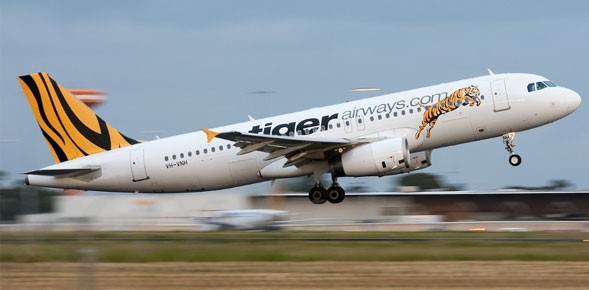Singaporean-based Tiger Air officially closes its Indonesian subsidiary on July 1st- in just four days time. It is the third failure of Tiger Air in its struggle to become a Pan-Asian carrier. Is it fate or bad management strategy from the Singapore based group?
BANGKOK – Speak about Singapore to other Asians. Generally they will qualify people as efficient, hard working but also arrogant. And this is true that the incredible growth of Singapore from a trading port into a world financial and economic metropolis justifies Singaporeans pride.
However, this pride has been often associated with in fact a way to look down at the rest of Asia. Generally Singaporean companies, when settling abroad, love to lecture and explain to the locals how good they are.
It will probably not be the case for Tiger Airways’ management. The carrier was born in 2003 from the will of both Singaporean government and State company Temasek to show that Singapore could also create a very successful low cost carrier similar to AirAsia. Probably the wrong motivation but Tiger Airways has since been a long painful succession of failures outside its protected home market.
The carrier had since its beginning in late 2003 the idea of becoming the second AirAsia, emulating its Malaysian counterpart with subsidiaries all across the continent. After managing to create a joint venture in Australia, the carrier had its first big setback in 2009. By then it announced to scrap plans to establish a joint-venture airline in South Korea, citing economic and regulatory uncertainties. The JV looked solid with the Incheon Metropolitan City Government being supporting 51% of the shares. 2011 was also challenging for the carrier, as Tiger struggles to concretely shape an attempt for a new low cost carrier in Thailand. The agreement was announced in early 2010 for a JV with Thai Airways international. However it was never approved from the government. Thai executives and officials let the project taking the water until it totally dissolved at the end of 2011.
At the same time, Tiger Air experienced troubles with its JV in Australia run in partnership with Virgin Australia. The carrier was faced with delays, cancellations and particularly safety issues. Australia Civil Aviation Safety Authority (CASA) ordered the carrier to suspend all its flights in 2011 due to severe lack of measures to address safety issues. It was a serious blow for the carrier’s image. After five weeks, CASA lifted the ban and Tigerair Australia recommenced operations on August 12, however only on the Sydney-Melbourne trunk line. The complete ban lift was completed at the end of October. However, Tigerair Australia had to close consequently two bases at Melbourne-Avalon and Adelaide. The airline is now growing again but continues to experience losses.
Tiger Airways looked also at the Philippines, buying 40% of ailing regional carrier SEAir in 2012. In March 2014, Tiger finally divested its stake to competitor Cebu Pacific following the completion of a cooperation agreement between Tigerair and Cebu Pacific. It is part of a strategic alliance between the two airlines with hub activities being coordinated. Both parties can now increase flight frequencies and jointly sell and market their routes.
Then came the joint venture with Mandala Air due to give to Tigerair Group a strong foothold into the Indonesian air market. Strategy proved wrong.
Tigerair Mandala grew very rapidly to secure position in the Indonesian market. However it was insufficient to break even or to attract enough passengers as capacities were still far behind the ones of its main competitors. In Tiger hands, Mandala incurred losses of about USD180 million. To the defense of the Singapore group, Tigerair Mandala suffered particularly of the highly competitive Indonesian air market and its resulting overcapacity. The strong depreciation of the Indonesian rupiah last year let also costs rise sharply.
For the full year ended 31 March 2014, Tiger Air Group recorded a group loss after tax of S$223.0 million, compared to the previous year’s loss after tax of $45.4 million. The strategy will now be totally different.
Tigerair Mandala disappearance puts an end to the dreams of Tiger Air to become a second AirAsia, a powerful pan-Asian carrier. Instead Tigerair will now focus on consolidating its Singapore activity. While yields continued to go down last year (-10%), Tiger Air now wants to focus at strengthening its frequencies rather than opening new routes. It cancelled recently an order for nine new aircraft Airbus A320 due to delivery in 2014 and 2015. The grounding of a few aircraft will help rebalance demand and supply. The carrier will also intensify with long-haul low cost carrier Scoot, also a subsidiary of Singapore Airlines.
Of course there is this new subsidiary bearing the Tiger Air name, Tiger Air Taiwan. However the Singaporean group owns only 10% of the shares. The carrier is due to start flying this year to Korea and Macau.
Tiger Air Group has now the ambition to be back as a Singapore local carrier. Maybe a bitter lesson of humility at the end for the airline’s management. Sometimes, growing step by step is the best solution.
Luc Citrinot a French national is a freelance journalist and consultant in tourism and air transport with over 20 years experience. Based in Paris and Bangkok, he works for various travel and air transport trade publications in Europe and Asia.



![[PR] PR_Ascott and Vimut Hospital_2024](https://www.traveldailynews.asia/wp-content/uploads/2024/04/PR-PR_Ascott-and-Vimut-Hospital_2024-400x265.jpg)








































































